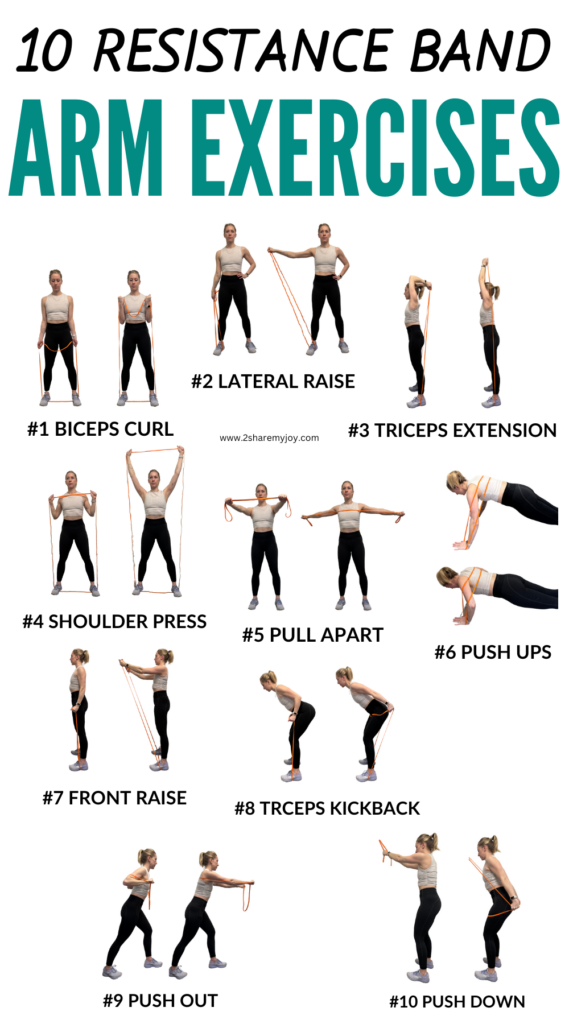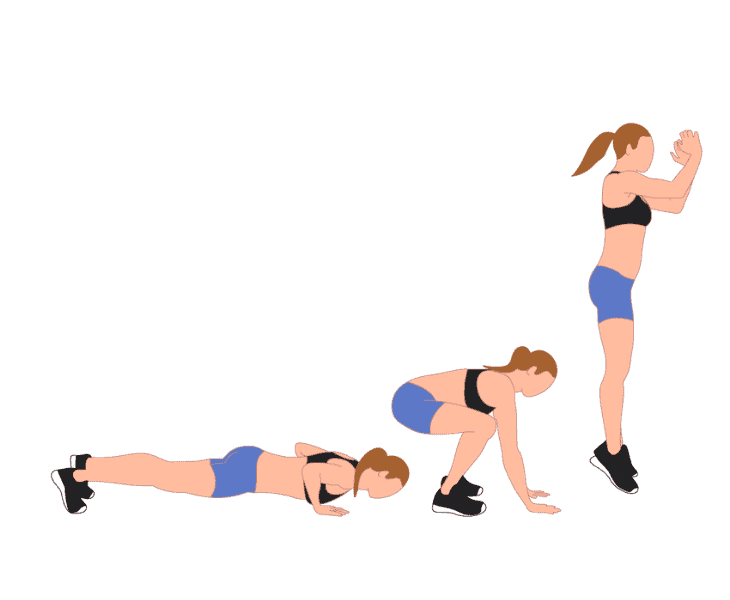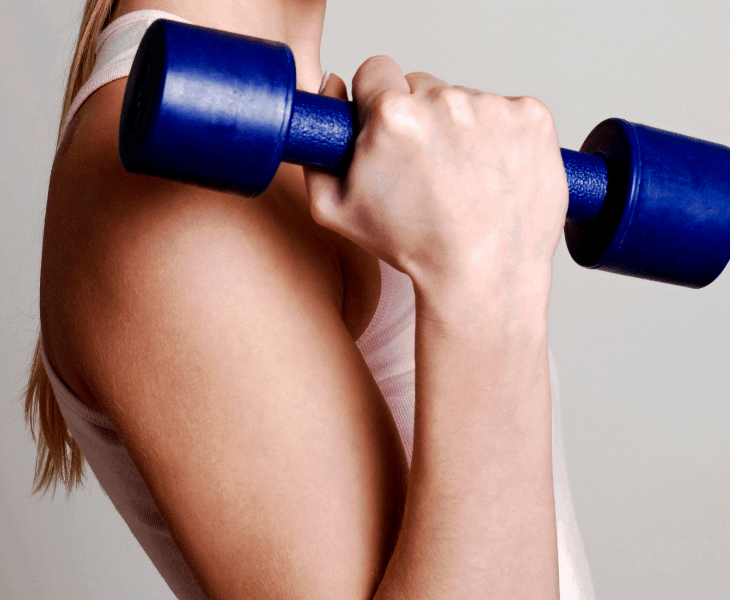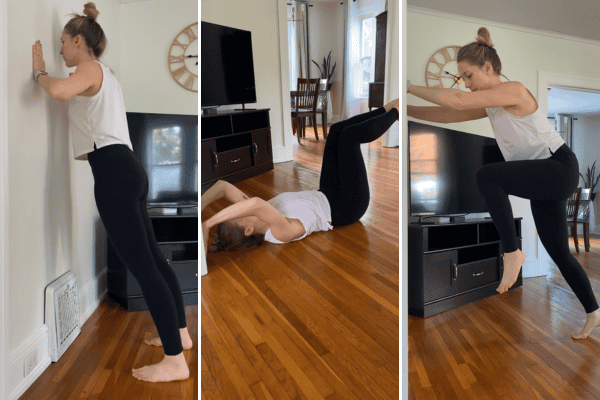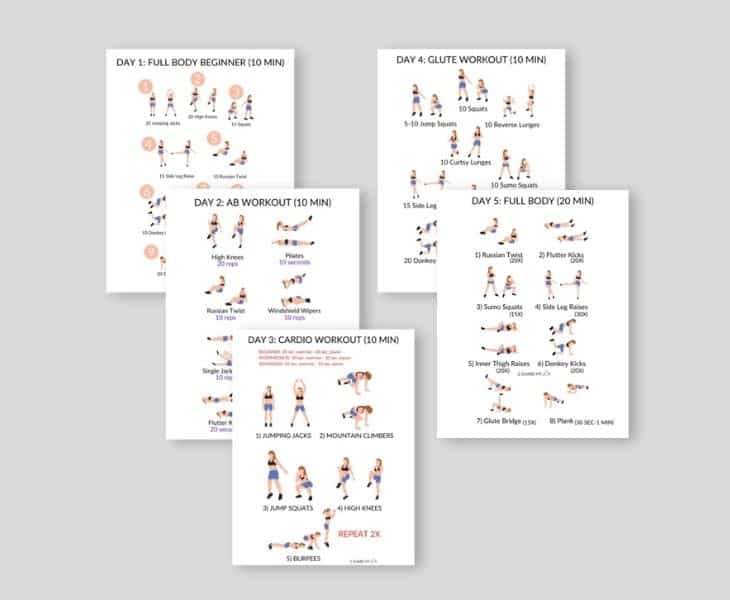Resistance Band Arm Exercises
Resistance band arm exercises offer a unique advantage for strengthening your upper body muscles. You can perform them almost anywhere with minimal space required.
These versatile tools provide adaptable levels of resistance, making them perfect for at-home muscle building. With a resistance band and some clear instructions, you can effectively target the arm muscles.
This beginner guide provides step-by-step directions to ensure you carry out each exercise correctly.
You’ll learn how to maneuver the bands to isolate and work different parts of the arm. From biceps to triceps, sideways to front, these exercises are designed to cover a full spectrum of movements.
More Resistance Band Workouts:
- Resistance Band Leg Workout
- Resistance Band Glute Workout
- Resistance Band Core Workout
- Resistance Band Back Workout
Resistance Band Arm Exercises at Home: Step-by-Step Instructions
I offer these detailed instructions as a path to toned and strong arms. By following them, you can develop a routine that fits seamlessly into your schedule.
Let’s maximize our at-home workout potential with these straightforward resistance band arm exercises.
#1 Resistance Band Bicep Curl
Starting your arm workout, the resistance band bicep curl stands out for its simplicity and effectiveness. You’ll want to focus on form to maximize the contraction of your biceps, the primary muscle group engaged in this exercise.
The beauty of the resistance band lies in its elasticity, which provides continuous resistance throughout the exercise, challenging your muscles with each inch of movement.
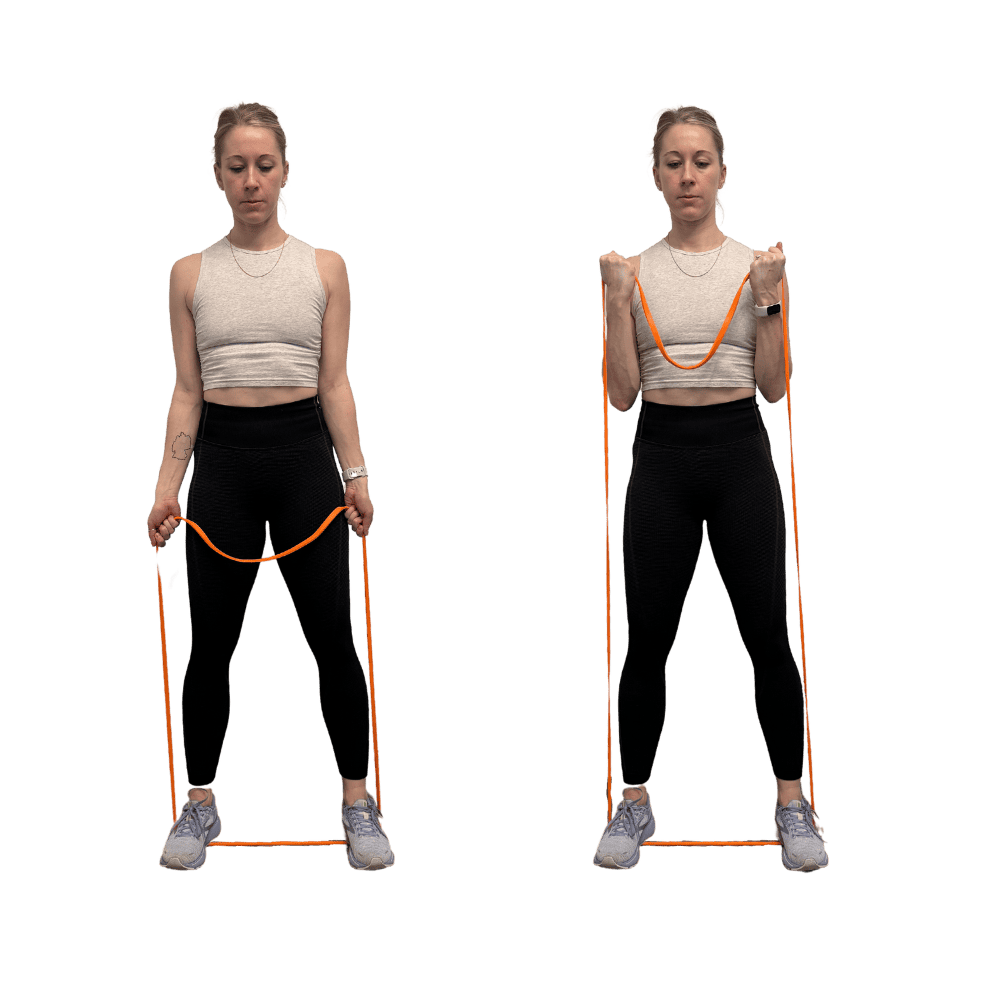
- Stand with your feet shoulder-width apart, stepping on the middle of the resistance band. Grasp each end with your hands, palms facing up.
- Keep your elbows close to your torso as you exhale and curl your hands towards your shoulders. You can adjust the resistance by widening or narrowing your stance, ensuring constant tension on the biceps.
- Inhale as you slowly lower your hands back to the starting position. Remember to keep your upper arms stationary throughout the movement; only your forearms should move.
- Performing the bicep curl correctly results in a peak pumping effect, essential for muscle growth and arm strength. As you repeat this motion, the steadfast pull of the band enhances muscle endurance and stimulates growth.
#2 Resistance Band Standing Lateral Raise
Standing lateral raises with a resistance band sculpt your shoulders and enhance muscle definition. The tension in the band will challenge your deltoid muscles, which cover the shoulder and support lifting movements.
This exercise requires a tactful increase in resistance; start with a lighter band and progress gradually. This consistency enhances muscle endurance and strength over time.
With regular practice, standing lateral raises can be a cornerstone in your at-home upper body routine, shaping stronger, more resilient shoulders.
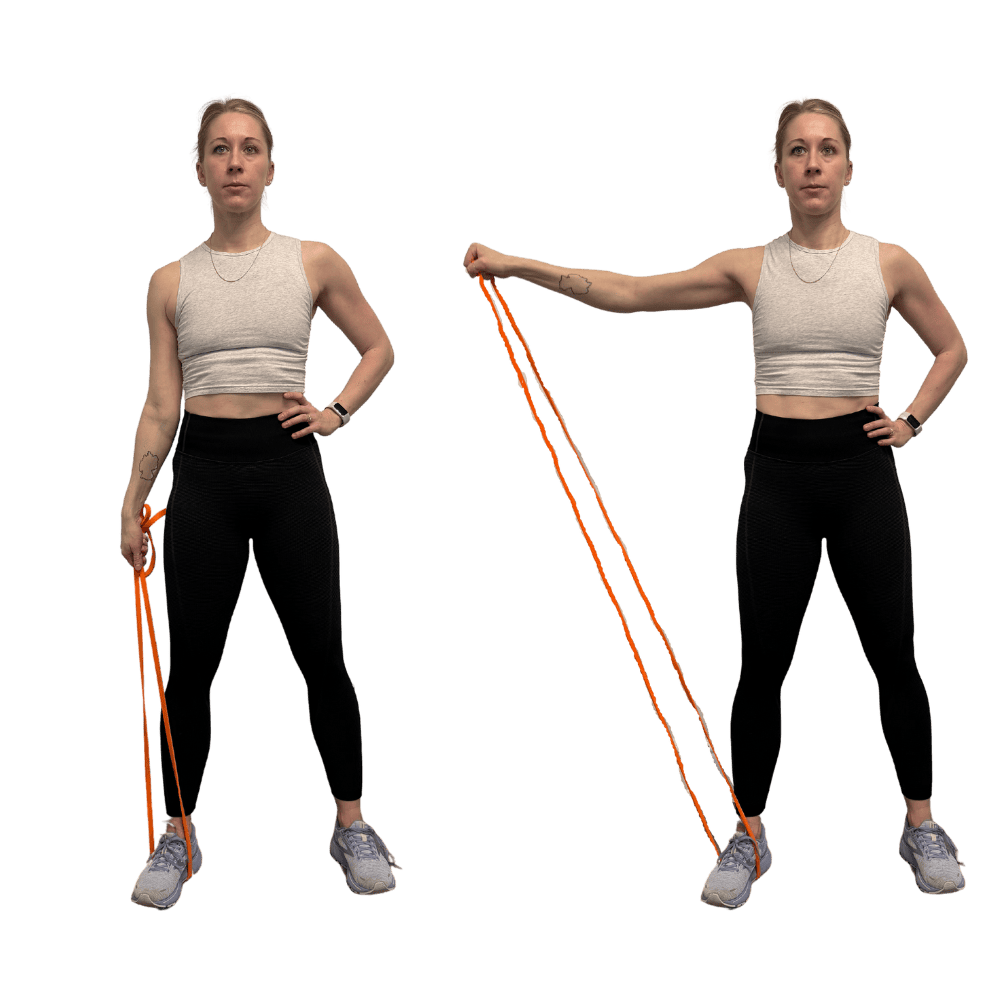
- Begin by placing both feet on the resistance band, roughly hip-width apart. Grip the band with palms facing inwards, arms by your sides. This is your starting position.
- Keep a slight bend in your elbows as you raise your arms to the side, ensuring they rise no higher than shoulder level.
- Exhale as you lift the bands and inhale while returning to the start. Aim for slow, deliberate movements—speed is not the objective here. Controlled motions ensure you work the deltoids through their full range of motion and avoid momentum taking over.
#3 Resistance Band Overhead Triceps Extensions
- Triceps extension with a resistance band begins with a stance that’s solid and steady. I plant my feet shoulder-width apart to make sure my base is stable.
- The resistance band slips beneath my feet, and I hold its ends with both hands. Then, I stretch my arms above my head, fully extending them with elbows pointing forward and the band taut.
- The key move here involves bending my elbows to lower the band behind my head. This action must be controlled; movement remains smooth, avoiding any jerking.
- Elbows stay close to my head, ensuring they don’t flare out. I pause briefly when my forearms are just about parallel to the floor, then I straighten my arms to return to the starting position, keeping tension in the triceps throughout.
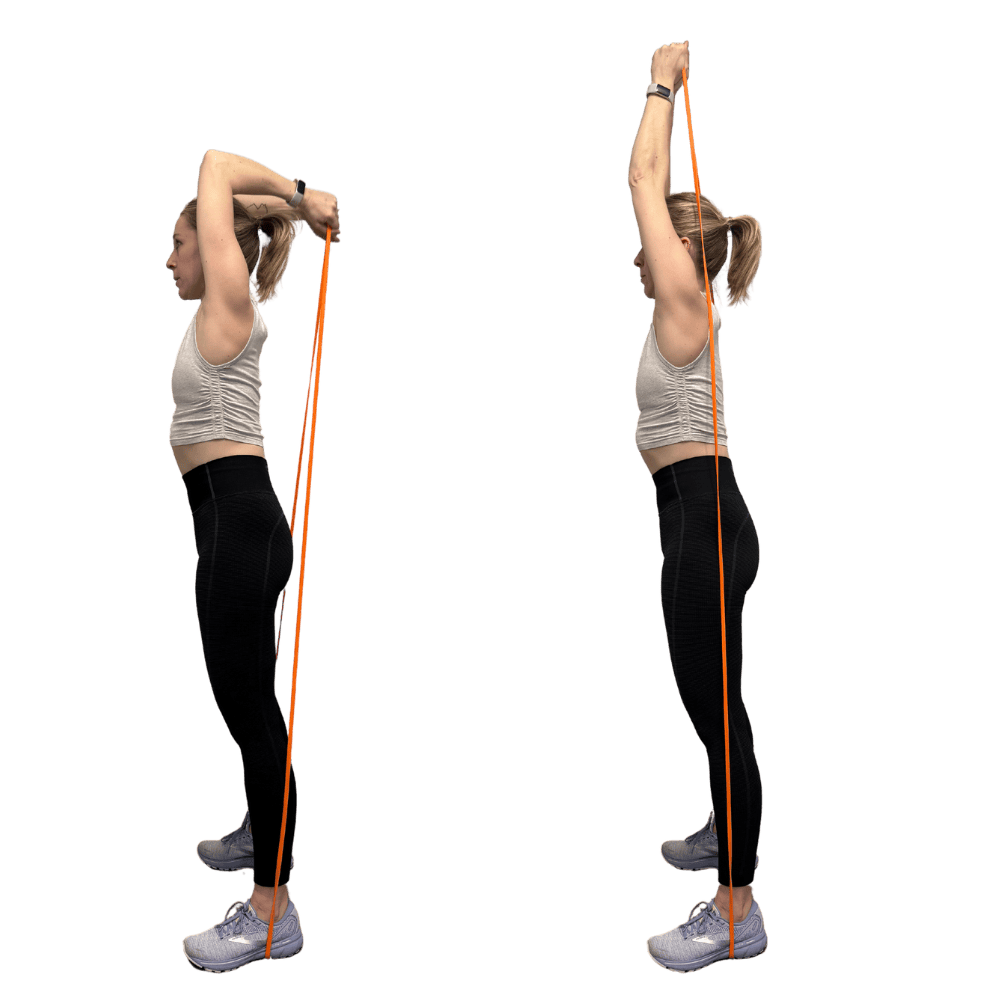
Posture matters greatly. I keep my core tight and my back straight to prevent strain. This precision channels the workout’s intensity directly into my triceps muscles.
With each repetition, those triceps contract, working hard against the resistance. Consistent practice of this exercise promises to strengthen and tone these muscles, contributing to more defined, sculpted arms over time.
#4 Resistance Band Overhead Shoulder Press
- To perform the overhead shoulder press with a resistance band, start by standing on the center of the band, feet hip width apart.
- Grab the ends with both hands, ensuring your grip is firm.
- Position your hands slightly wider than shoulder-width apart, palms facing forward.
- Push up until your arms are fully extended above your head, then lower back down with control. This movement should be smooth and steady to maintain tension on the band.
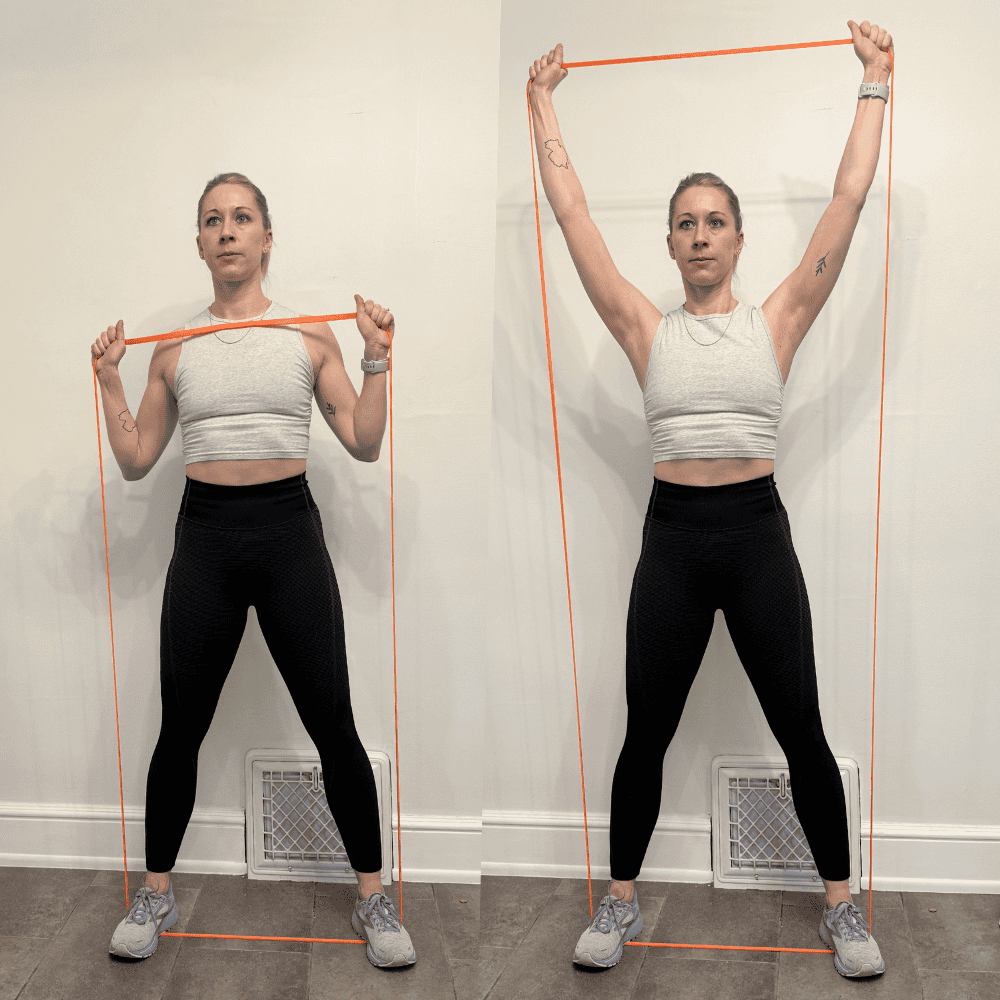
The overhead press targets the deltoids, which cap your shoulders. It also engages your triceps and upper back muscles.
To keep consistent tension on the band, avoid rushing the movement. Take a moment at the top to ensure your muscles are fully engaged. By doing so, you activate your shoulder muscles effectively throughout the entire exercise.
Correct posture is key in this workout; keep your core tight and back straight. This not only protects your spine but also ensures that your shoulders get the full benefit of the exercise.
With regular practice, you can expect to see strength and definition in your shoulder area, resulting in toned and sculpted arms.
#5 Resistance Band Pull Apart
- Grasping a resistance band with both hands, I stand tall and hold the band out in front of me at shoulder height.
- I make sure my grip is wider than my shoulders to create proper tension.
- Then, engaging my core, I pull the band apart by moving my hands out to the sides while keeping my arms straight.
- I focus on squeezing my shoulder blades together as my arms open wide.
- I take my time and perform each rep with controlled movements, ensuring a consistent pull apart on the band.
- A slow return to the starting position keeps the muscles under tension. The smooth motion helps to better target my upper back and shoulder muscles without causing strain.
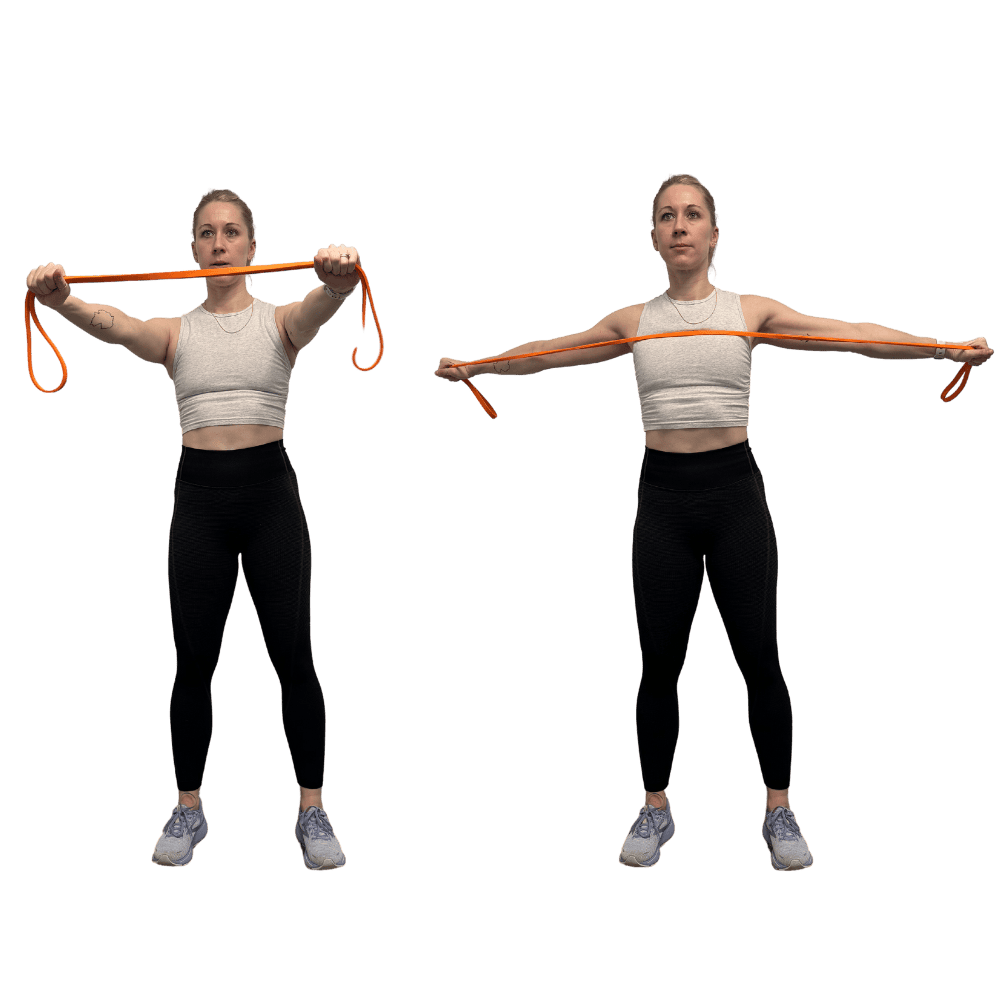
The resistance band pull apart is a fantastic exercise for improving posture. It strengthens the muscles responsible for pulling the shoulders back, combating the hunched stance brought on by daily activities like sitting at a computer.
Regularly including this move in my workout helps me maintain an upright and confident posture.
#6 Resistance Band Push Ups
Traditional push-ups engage multiple muscle groups, making them a versatile exercise. Add a resistance band, and you amplify the intensity.
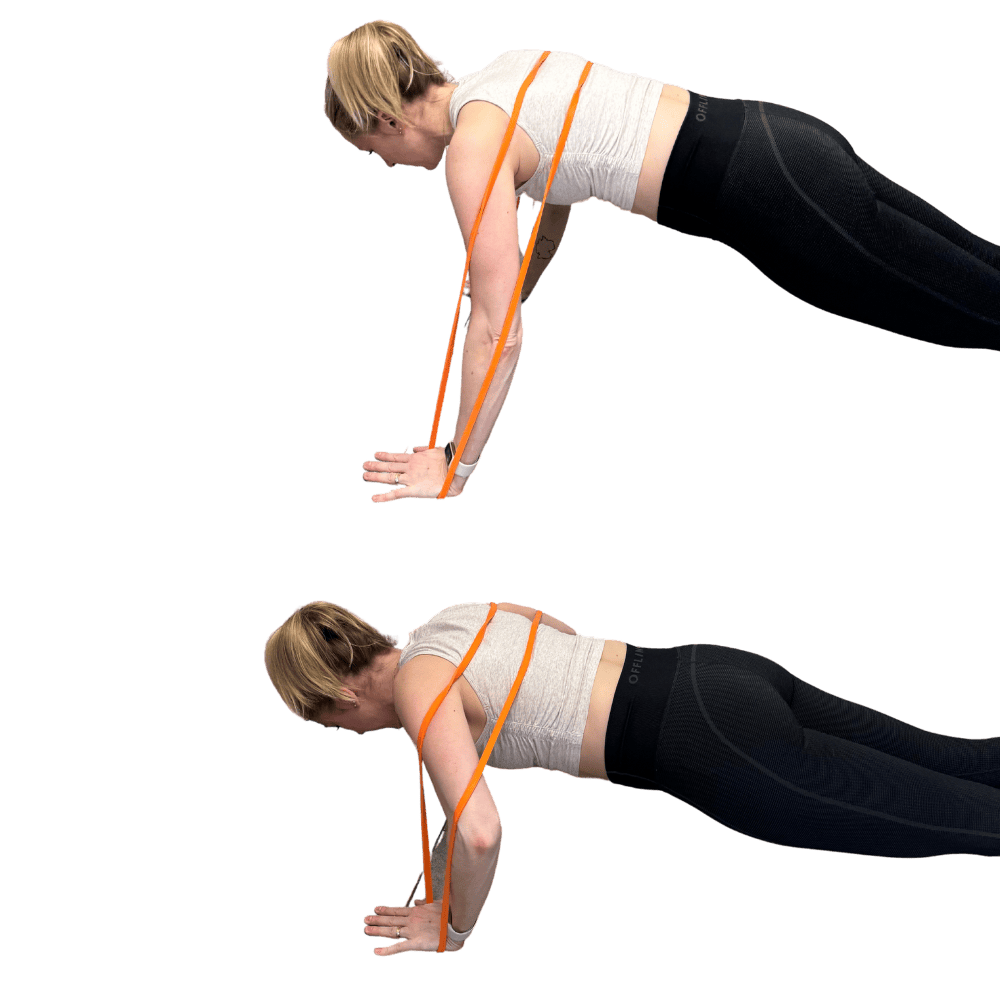
- To integrate bands into your push-ups, place the band across your back and secure it under your hands.
- You’ll notice the elasticity adds resistance as you push upward, demanding more power from your chest and arms.
This modification ensures every push-up works your muscles harder, accelerating strength and muscle growth.
The enhancement doesn’t just stop at muscle development; these push-ups can also elevate your core stability. With the band’s constant tension, your core must work to stabilize your body, improving your balance and posture.
Focus on maintaining a smooth, controlled movement both upwards and downwards to leverage the full potential of the exercise.
Resistance band push-ups transform a familiar workout into a challenging, muscle-building routine. By incorporating this technique, you can expect a noticeable increase in upper body strength.
Give this exercise a try, and track your progress as you push towards a stronger version of yourself.
#7 Resistance Band Straight Arm Push Downs
Pull downs or push downs work many arm muscles but also work the lats and some of your back muscles. It is a great exercise to improve posture.
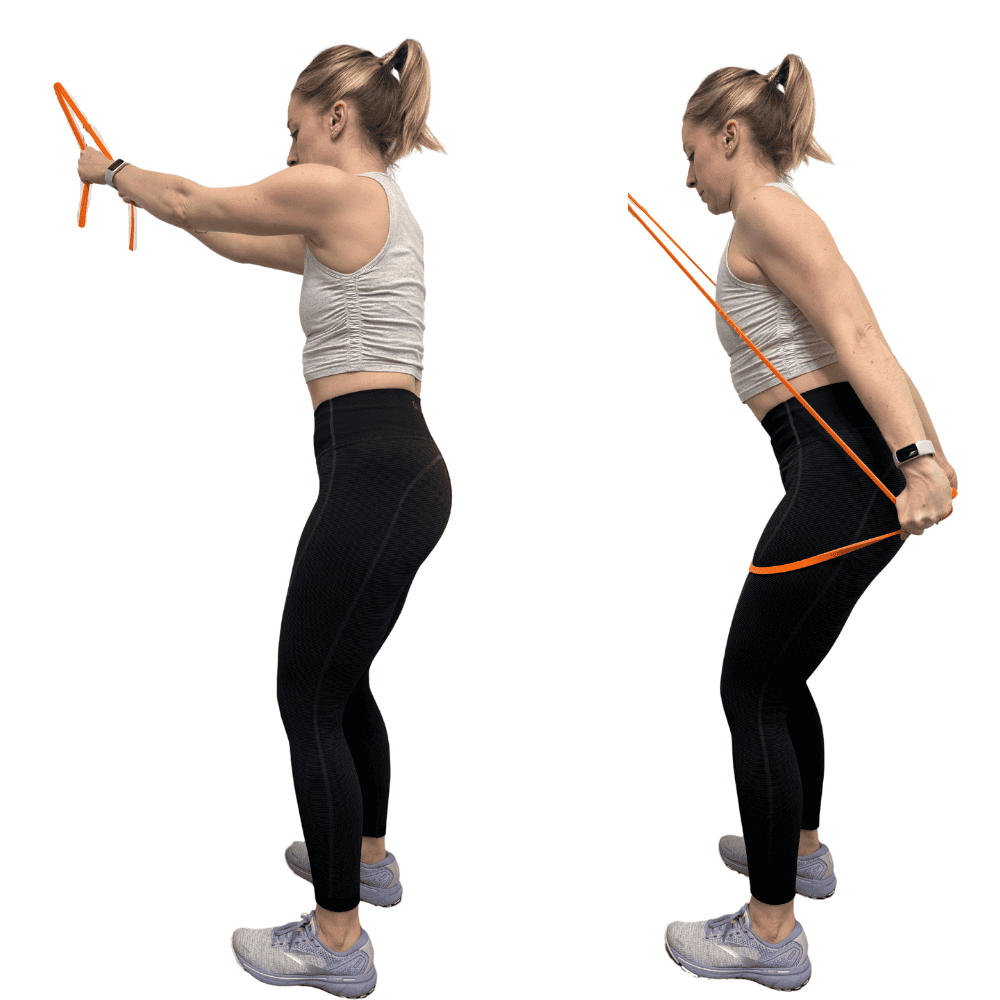
- Securely anchor the resistance band to a fixed point above head height. This could be a pull-up bar, door frame anchor, or any stable structure.
- Stand facing the anchor point where the resistance band is attached. Your feet should be hip-width apart for stability.
- Hold the resistance band with both hands, using an overhand grip. Your hands should be positioned shoulder-width apart.
- Step back to create tension in the resistance band. Stand with a straight posture, shoulders pulled back, and core engaged. Your arms should be fully extended in front of you
- Begin with your arms extended downward, pulling the resistance band taut. This is your starting position.
- Initiate the movement by pushing the band downward by straightening your arms. Keep your elbows locked and close to your body throughout the movement.
- Focus on engaging your triceps as you push the band down. Contract your triceps at the end of the movement.
- At the bottom of the movement, your arms should be fully extended downward, and you should feel a strong contraction in your triceps.
- Slowly raise your arms back to the starting position, maintaining tension on the resistance band. Avoid letting the band snap back quickly.
Pull downs or push downs work many arm muscles but also work the lats and some of your back muscles. It is a great exercise to improve posture.
#8 Resistance Band Front Raises
- To kick off resistance band front raises, stand with feet shoulder-width apart.
- Place the middle of the band under your feet, securing it firmly. Grab the ends of the band with palms facing your thighs. This is your starting position.
- From here, with a slight bend in your elbows, raise your arms straight in front of you. Lift until they’re parallel with the floor, engaging your core throughout.
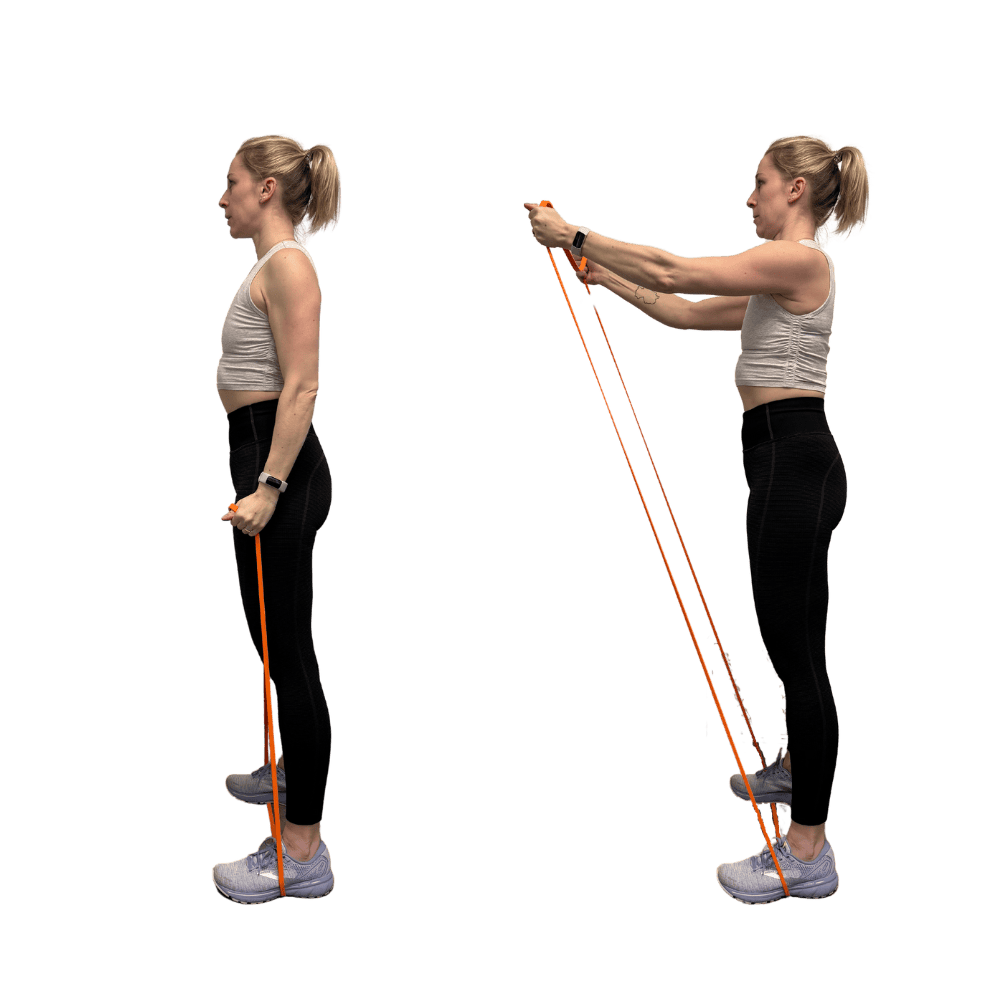
Stay mindful of your shoulders during this exercise. Keep them relaxed and down, away from your ears. This will help prevent strain and promote muscle engagement in the desired areas.
Slowly lower your arms back down to the starting position and repeat the motion with controlled movements.
Front raises with a resistance band primarily work the anterior deltoids, the front part of your shoulder muscles. Consistent practice helps develop the deltoids, leading to toned and strengthened shoulders.
As with any movement, focusing on form is key to maximizing benefits and minimizing injury risks.
#9 Resistance Band Triceps Kickbacks
- To execute triceps kickbacks with a resistance band, start by standing on the middle of the band. Keep your feet shoulder-width apart for stability.
- Grasp the ends of the band with your hands, ensuring your palms face inward. Bend your knees slightly, hinge from the hips, and maintain a straight back to get into the starting position.
- Your upper arms should be close to your body, elbows at a 90-degree angle.
- From here, push your hands back until your arms are fully extended, focusing on the contraction of your triceps.
- You should feel them working as the band’s resistance intensifies through the movement.
- Return to the starting position with a controlled motion, resisting the band’s pull to maximize the exercise’s impact. Repeat for a set number of reps.
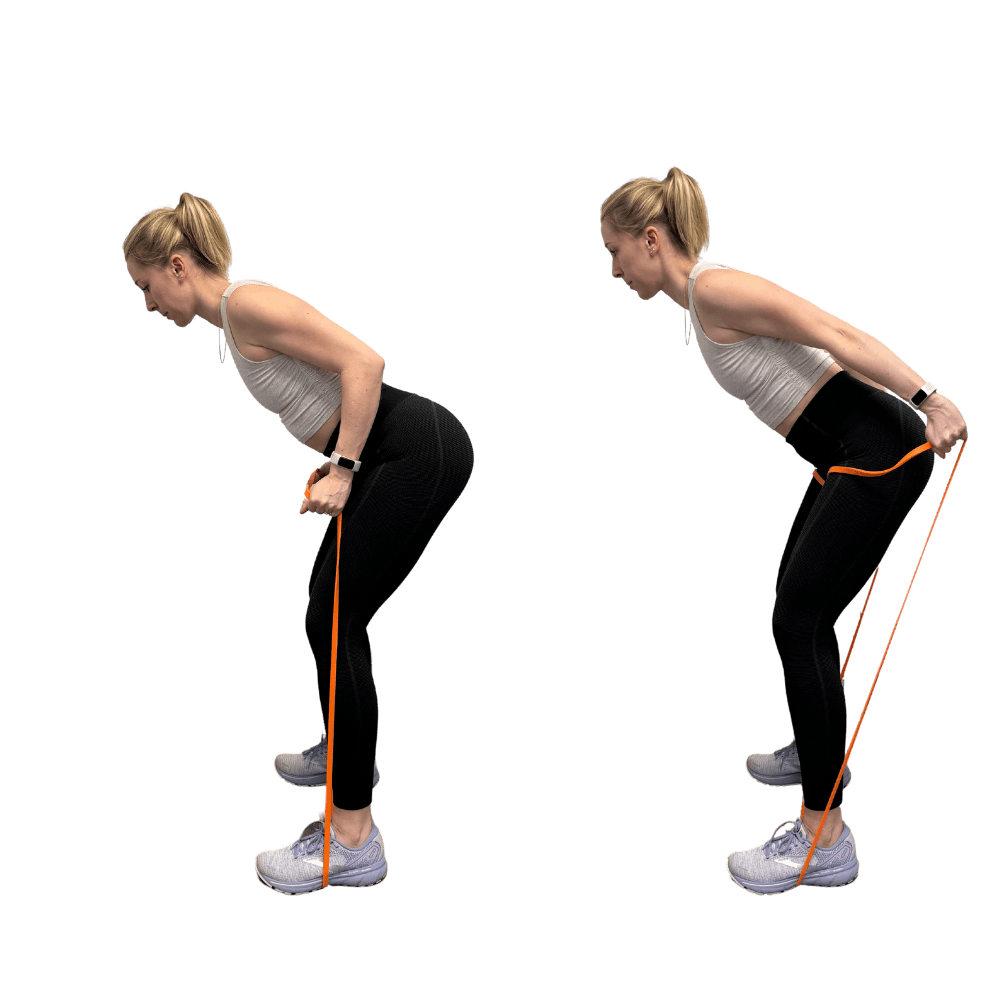
By concentrating on the triceps during kickbacks, the muscle works against the band’s tension, leading to better arm toning and shaping.
This exercise targets your triceps brachii, which are crucial for stronger, well-defined arms. Regular performance contributes to a sculpted upper body, making the triceps kickback a key move in your resistance band arm workout routine.
#10 Resistance Band Arm Exercise: Push Outs
Resistance band push outs serve as an excellent move to fortify your arm and chest muscles. You can perform this exercise with a band affixed at chest height.
- You can anchor the band chest hight, or wrap it around your back.
- Grasp the ends with both hands and assume a half-squat position. Ensure that your feet are shoulder-width apart for a stable stance. Draw your belly in and keep your back straight.
- Now, push the band straight out in front of you until your arms are fully extended. Keep your movements controlled; don’t let the band snap back.
- Bring your hands back to your chest slowly and repeat the process. This exercise demands focus on form to prevent straining your shoulders. Your wrists should remain firm, and elbows slightly bent during the extension.
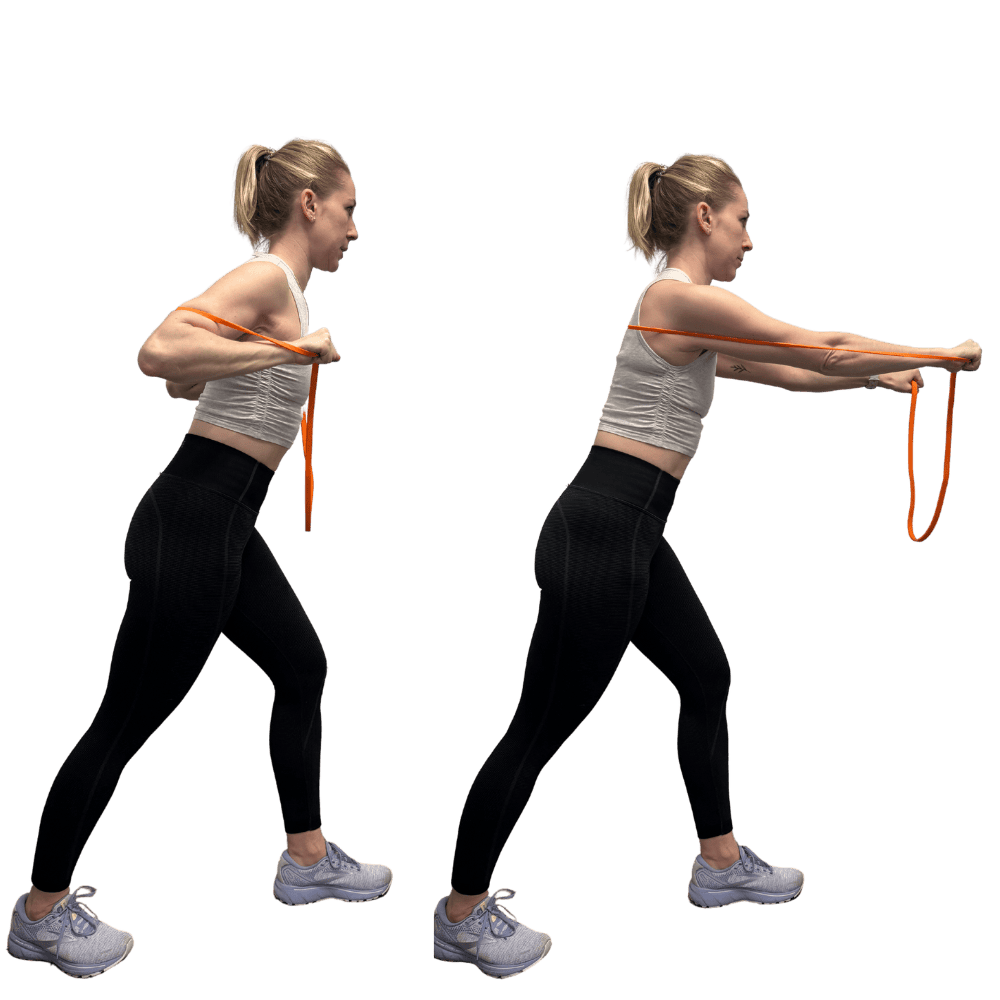
Push outs are not just about strength; they also improve your muscle endurance. By incorporating this movement into your routine, you’ll notice increased stamina during other upper-body workouts.
Over time, your ability to perform more reps or use a heavier resistance band will grow, showcasing the practical impact of push outs on muscle endurance.
Do Resistance Bands Tone Your Arms?
Many fitness enthusiasts ask if resistance band arm exercises can truly tone the arms, and I’ve found the answer to be a resounding yes. These flexible tools are fantastic for enhancing strength and defining muscles without heavy equipment.
I’ve witnessed a significant transformation in my arm structure using them consistently. For instance, after incorporating resistance band exercises into my routine, my biceps and triceps became more defined within weeks.
Unlike free weights, bands provide constant tension throughout the movement, forcing muscles to work harder and thereby promoting growth.
In my experience, the variety of exercises available with bands can target every arm muscle, ensuring a comprehensive arm workout. Adding resistance bands has been a game-changer, offering a cost-effective, spacious, and versatile approach to fitness that yields visible results.
How Do You Get Rid of Flabby Arms with Resistance Bands?
Fighting flabby arms becomes more manageable with resistance bands, as the tension they provide challenges your muscles effectively.
You can follow a routine that includes exercises such as bicep curls, triceps kickbacks, and shoulder presses. These workouts specifically aim to tighten and tone your biceps, triceps, and deltoids, giving your arms a more sculpted appearance.
Begin your routine with bicep curls, standing on the band and curling upwards with palms facing forward. This targets the front of your arms. Pair this move with triceps kickbacks; hinge forward slightly, pulling the band back and focusing on the back of your upper arms for a balanced workout.
Implement shoulder presses next, pressing the band overhead to work on your overall arm strength and shoulder stability.
Maintaining a regular exercise schedule enhances the results, as consistency is key to muscle development and fat loss. Commit to your resistance band arm exercise routine several times a week, steadily increasing the challenge by tightening the band or progressing to a stronger one.
Coupled with a balanced diet and cardiovascular activity, these arm exercises will contribute significantly to reducing flabbiness and enhancing muscle tone.
How Do You Build Arm Muscle with Resistance Bands?
Building arm muscle with resistance bands involves strategy and commitment. Start with moderate tension to master form, then gradually increase resistance to challenge your muscles.
This approach encourages muscle growth and strength gains. Embrace a variety of exercises to target all arm muscle groups and prevent plateaus.
One key to muscle building is consistency and progressive overload. Commit to a regular workout schedule. Mix in different resistance band arm exercises, including curls, presses, and pull-aparts. Then focus on using “heavier” resistance bands or increase reps.
This ensures comprehensive development of the biceps, triceps, and shoulders. To maximize gains, maintain tension on the muscles throughout each exercise. Full range of motion and controlled movements deepen muscle engagement.
Resistance bands offer great flexibility for workout routines. They can be used anywhere, at any time, making them perfect for those with busy schedules.
This adaptability ensures you can keep your arm workout regimen consistent, even when a gym isn’t accessible. With dedication and the right approach, resistance bands can be a powerful tool in building and sculpting muscular arms at home.
Can You Get an Effective Arm Workout with Resistance Bands?
Many dismiss resistance bands as less effective than heavy weights for arm strength. I’ve found that misconception far from the truth.
Resistance band arm workouts can indeed rival traditional strength training. I’m here to tell you that the elasticity of these bands introduces a unique challenge, activating arm muscles through constant tension.
“Elastic resistance training is able to promote similar strength gains to conventional resistance training, in different population profiles and using diverse protocols.”
source
Unlike dumbbells or barbells that rely on gravity, resistance bands create resistance from various angles. This multiplanar tension targets the arms in a way free weights simply can’t.
Plus, the portability of bands allows me to keep my arm training consistent, not missing workouts due to travel or lack of gym access. I can perform exercises like bicep curls, tricep extensions, and shoulder presses effectively with these versatile tools.
The flexibility to adjust resistance simply by changing the band’s length or thickness is a game changer. I maintain muscle growth without stocking multiple weights!
I conclude with confidence, resistance bands deliver substantial results for anyone dedicated to toning and strengthening their arms.
Including these adaptable accessories in an arm workout ensures an efficient and effective training session.
Let’s not overlook the simplicity and functionality these bands bring to the table, allowing everyone to achieve powerful, well-defined arms.
Benefits of Working Out with Resistance Bands
Resistance bands offer a multitude of benefits that make them a standout choice for fitness enthusiasts at every level.
Their low cost makes them accessible to a wide audience, allowing you to invest in fitness without breaking the bank. This simple piece of equipment can facilitate full-body workouts with a focus on toning the arms; it exemplifies cost-efficiency and practicality in the realm of exercise gear.
One significant advantage of resistance bands lies in their portability. You can easily fold them up, toss them in a bag, and take them wherever you go.
Whether you find yourself in a cramped hotel room or a spacious park, they allow you to maintain your fitness routine.
This versatility extends to the exercises themselves; bands can be modified for use in a variety of strength-building movements, adapting to different fitness levels and goals.
Beginners find resistance bands approachable due to their ease of use and the gradual learning curve they offer.
For those just starting their fitness journey, bands provide a low-impact option to build strength without overwhelming the muscles or joints.
In contrast, advanced users leverage the bands to add intensity to their workouts or focus on muscle endurance and stabilization in ways that free weights alone cannot provide.
With resistance bands, you engage in a style of strength training that emphasizes controlled movement and tension, key components for muscle growth and endurance.
This makes them a prized tool for those aiming to enhance their physical fitness, no matter their starting point.
